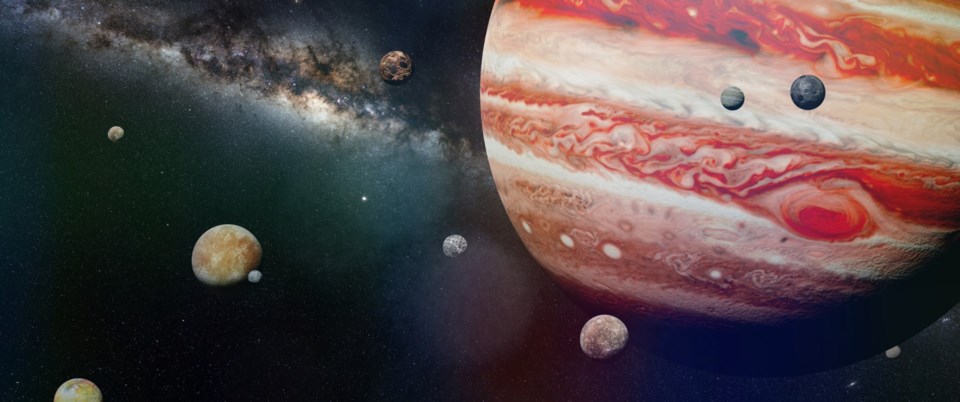The moon is at first quarter when November begins, “quarter” being one-fourth of the lunar month (“moonth”–that’s where the word comes from), beginning at new moon. Each quarter is approximately 7.4 days, times four equals ~29.5 days from one full moon to the next full moon. Saturn is hovering over the moon that same night, four degrees north. Nov. 3, minor planet Juno is occulted by the moon for Â鶹ÊÓƵern Hemisphere viewers, a one-degree separation for northern viewers. The following day sees Neptune and Jupiter three and four degrees north, respectively. Full moon is Nov. 8, which is also a total lunar eclipse, well placed for North American viewers, but in the early morning. By Nov. 11, Mars is two degrees south of our satellite, and Nov. 13, the bright star Pollux is 1.7 degrees north. The moon is new Nov. 23, and rounding out the month, Saturn is once again four degrees north of a first-quarter moon Nov. 29.
Mercury is in front of the sun, so not visible.
Venus is behind the sun, so not visible.
Mars is in the constellation, Taurus, the bull, retrograding for the next couple of months. As it nears Earth, the Red Planet brightens significantly from magnitude -1.2 to mag. -1.8, getting closer and closer, until reaching closest approach for 2022 in early December. The moon glides by to the north on the night of the Nov. 11.
Jupiter lights up the night as the second brightest planet after Venus. The gas giant dominates the night sky, rising in the east at sundown and staying visible all through the night. The moon shares the vista on the night of Nov. 4. Jupiter has been retrograding, and reaches its westerly stationary point Nov. 24, thereafter moving eastward in prograde motion.
Saturn began prograde motion in October, so is slowly moving eastward against the starry backdrop. There are two encounters with the moon this month, as noted above, Nov. 1 and 29.
Uranus is occulted Nov. 8 as described in the moon section above, but, more importantly, reaches opposition Nov. 9. So, with the sun directly behind us at midnight, Uranus will be directly south, high in the sky, following the autumn ecliptic.
Neptune is high in the sky at sunset, just a bit west of Jupiter. In the second week of November, one can see all of the outer planets and the moon lined up from Saturn, setting in the west around midnight, through Neptune, Jupiter, Uranus (and the moon), to Mars, high overhead. Adding to the enjoyment are the stars of the Pleiades, Taurus, and Orion.
The south Taurid meteor shower peaks Nov. 5.
Daylight Saving Time ends on Sunday, Nov. 6.
The north Taurid meteor shower peaks Nov. 12.
On the last day of the month, Juno is occulted for viewers in most of North America.
James Edgar has had an interest in the night sky all his life. He joined the Royal Astronomical Society of Canada in 2000, was national president for two terms, is now the editor of the Observer’s Handbook, and production manager of the bi-monthly RASC Journal. The IAU named asteroid 1995 XC5 “(22421) Jamesedgar” in his honour and in 2021 he was awarded a Fellowship of the RASC.




